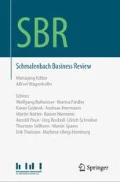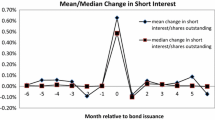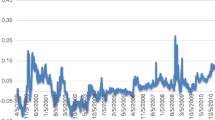Abstract
This paper analyzes the structure and pricing of liquidity risk for international listed buyout funds. We use a time-series framework for our tests which allows us to discriminate between the exposure of buyout funds to two types of liquidity: Market and funding liquidity. We find that the innovation in funding liquidity is a priced factor for buyout funds, while changes in market liquidity are not. Investors require a risk premium of approximately 3% to 7% per annum in order to be compensated for bearing that risk. Controlling for funding liquidity risk decreases the alpha of the asset class to zero.
Similar content being viewed by others
Notes
In this paper, we refer to buyout funds as a subcategory of the larger private equity asset class, that also includes, e.g., venture capital.
In this respect, our paper contributes to a growing strand of literature that has documented liquidity risk, interpreted as innovations in aggregate liquidity, to be a priced factor for a broad array of asset classes. Pástor and Stambaugh (2003), for example, analyze the pricing of liquidity risk in the stock market. Chordia et al. (2005) provide a study on stock and bond returns and analyze the links between both markets. Sadka (2010) analyzes liquidity risk in hedge-fund returns and Bekaert et al. (2007) study liquidity and stock returns in emerging markets. Far less, however, is known on the relationship between private equity and liquidity risk.
Generally, market liquidity refers to the ability to trade large quantities of an asset (i) quickly, (ii) at low cost, and (iii) without influencing the price of the asset, whereas funding liquidity simply refers to the ease with which funding can be obtained (Pástor and Stambaugh 2003; Boyson et al. 2010).
Bergmann et al. (2010) provide a detailed overview of the organizational forms of listed private equity.
See Kaplan and Strömberg (2009) for a more detailed discussion on the private equity business model.
In untabulated results, we verify that the exclusion of the least liquid instruments does not lead to circularity issues in the estimation of liquidity exposures.
The numbers are based on 16 FoFs which disclose sufficiently detailed information about their investment portfolio in 2010.
Specifically, the Kaplan and Schoar (2005) “Public Market Equivalent” (PME) of traditional buyout funds is virtually one, when the cash flows of these funds are discounted with the returns of a portfolio of listed buyout instruments. The result is robust in all subperiods.
We have 22 FoFs with a buyout focus, while Jegadeesh et al. (2015) have 24 funds, including venture FoFs.
In case a fund is delisted from the stock exchange, the portfolio is rebalanced on the last trading day.
The time-series of the liquidity factors can be obtained from Lubos Pastor’s website, http://faculty.chicagobooth.edu/lubos.pastor/research/.
The correction for autocorrelation is based on the full sample and therefore may introduce a look-ahead bias. However the correction does not drive the findings presented below, which is verified from a robustness test.
See http://www.federalreserve.gov/boarddocs/SnLoanSurvey/default.htm. The survey asks a panel of large US domestic, and US branches of foreign banks, whether they tightened or loosened their credit standards relative to the previous quarter and reports the net-percentage of respondents that tightened their standards.
Similar data from e.g., individual member countries of the European Central Bank (ECB), or the Bank of England are available only from 2003 and 2007 respectively. We, however, find a correlation between the Federal Reserve’s survey and the results of the German “Bundesbank”, an important member of the ECB to be 0.61.
Drehmann and Nikolaou (2013) analyze the interaction between market and funding liquidity risk and report that a close relationship only emerges during the financial crisis; in particular, they find no significant relationship prior to the crisis. Their observation period covers June 2005 to October 2008, since the authors proxy for funding liquidity risk from banks’ bids on open market operations performed by the the European Central Bank. Similarly, Adrian et al. (2014) find that market and funding liquidity are not intertwined.
Franzoni et al. (2012, p. 2356).
The market price of risk for a non-traded risk factor must be estimated from the cross-section of asset returns. Assuming integrated markets, the price of risk of a traded position directly corresponds to the time-series average of the factor’s returns (e.g., Shanken 1992) or Balduzzi and Robotti 2008) and the cross-section of asset returns bears no additional information.
The data is obtained from https://fred.stlouisfed.org.
References
Adrian, T., E. Etula, and T. Muir. 2014. Financial intermediaries and the cross-section of asset returns. Journal of Finance 69(6):2557–2596.
Amihud, Y. 2002. Illiquidity and stock returns: cross-section and time-series effects. Journal of Financial Markets 5(1):31–56.
Ang, A., B. Chen, W.N. Goetzmann, and L. Phalippou. 2014. Estimating private equity returns from limited partner cash flows. Working paper
Axelson, U., T. Jenkinson, P. Strömberg, and M.S. Weisbach. 2013a. Borrow cheap, buy high? The determinants of leverage and pricing in buyouts. Journal of Finance 68(6):2223–2267.
Axelson, U., M. Sorensen, and P. Strömberg. 2013b. The alpha and beta of buyout deals. Working paper
Balduzzi, P., and C. Robotti. 2008. Mimicking portfolios, economic risk premia, and tests of multi-beta models. Journal of Business & Economic Statistics 26(3):354–367.
Bekaert, G., C.R. Harvey, and C. Lundblad. 2007. Liquidity and expected returns: lessons from emerging markets. Review of Financial Studies 20(6):1783–1831.
Bergmann, B., H. Christophers, M. Huss, and H. Zimmermann. 2010. Listed private equity. In Companion to private equity, ed. D.J. Cumming, 53–70. Hoboken: Wiley & Sons.
Blaydon, C., and M. Horvath. 2002. Whats a company worth? It depends on which GP you ask. Venture Capital Journal, May:40–41.
Boyson, N.M., C.W. Stahel, and R.M. Stulz. 2010. Hedge fund contagion and liquidity shocks. Journal of Finance 65(5):1789–1816.
Brophy, D.J., and M.W. Guthner. 1988. Publicly traded venture capital funds: implications for institutional “fund of funds” investors. Journal of Business Venturing 3(3):187–206.
Brunnermeier, M.K., and L.H. Pedersen. 2009. Market liquidity and funding liquidity. Review of Financial Studies 22(6):2201–2238.
Brunnermeier, M.K., S. Nagel, and L.H. Pedersen. 2008. Carry trades and currency crashes. NBER working paper no. 14473
Carhart, M.M. 1997. On persistence in mutual fund performance. Journal of Finance 52:57–82.
Chordia, T., A. Sarkar, and A. Subrahmanyam. 2005. An empirical analysis of stock and bond market liquidity. Review of Financial Studies 18(1):85–129.
Cochrane, J.H. 2005a. Asset pricing, 2nd edn., Princeton: Princeton University Press.
Cochrane, J.H. 2005b. The risk and return of venture capital. Journal of Financial Economics 75:3–52.
Cumming, D., and U. Walz. 2010. Private equity returns and disclosure around the world. Journal of International Business Studies 41(4):727–754.
Drehmann, M., and K. Nikolaou. 2013. Funding liquidity risk: definition and measurement. Journal of Banking and Finance 37:2173–2182.
Driessen, J., T.-C. Lin, and L. Phalippou. 2012. A new method to estimate risk and return of non-traded assets from cash flows: the case of private equity funds. Journal of Financial and Quantitative Analysis 47(3):511–535.
Fama, E., and K.R. French. 1993. Common risk factors in the returns on stocks and bonds. Journal of Financial Economics 33(1):3–56.
Fama, E.F., and K.R. French. 1989. Business conditions and expected returns on stocks and bonds. Journal of Financial Economics 25(1):23–49.
Fama, E.F., and MacBeth. 1973. Risk, return and equilibrium. Journal of Political Economy 81:607–636.
Ferson, W.E., and C.R. Harvey. 1993. The risk and predictability of international equity returns. The Review of Financial Studies 6(3):527–566.
Franzoni, F., E. Nowak, and L. Phalippou. 2012. Private equity performance and liquidity risk. Journal of Finance https://doi.org/10.1111/j.1540-6261.2012.01788.x.
Gompers, P.A. 1996. Grandstanding in the venture capital industry. Journal of Financial Economics 42:133–156.
Gompers, P.A., and J. Lerner. 2001. The venture capital revolution. Journal of Economic Perspectives 15(2):145–168.
Gottschalg, O., and L. Phalippou. 2009. The performance of private equity funds. Review of Financial Studies 22(4):1747–1776.
Goyenko, R.Y., C.W. Holden, and C.A. Trzcinka. 2009. Do liquidity measures measure liquidity? Journal of Financial Economics 92(2):153–181.
Hall, R.E., and S.E. Woodward. 2003. Benchmarking the returns to venture. NBER working paper no. 10202
Hansen, L.P. 1982. Large sample properties of generalized method of moments estimators. Econometrica 50(4):1029–1054.
Harris, R.S., T. Jenkinson, and S.N. Kaplan. 2014. Private equity performance: What do we know? Journal of Finance 69(5):1851–1882.
Huss, M. 2014. Public market prices for private equity? Working paper
Jagannathan, R., G. Skoulakis, and Z. Wang. 2010. The analysis of the cross-section of security returns. In Handbook of financial econometrics, Vol. 2, ed. Y. Aït-Sahalia, L.P. Hansen, 73–129. Amsterdam: North-Holland.
Jegadeesh, N., R. Kräussl, and J. Pollet. 2015. Risk and expected returns of private equity investments: evidence based on market prices. Review of Financial Studies 28(12):3269–3302.
Kaplan, S.N., and A. Schoar. 2005. Private equity performance: returns, persistence, and capital flows. Journal of Finance 60(4):1791–1823.
Kaplan, S.N., and P. Strömberg. 2009. Leveraged buyouts and private equity. Journal of Economic Perspectives 23(1):121–146.
Lerner, J. 1994. The syndication of venture capital investments. Financial Management 23(3):16–27.
Ljungqvist, A., and M. Richardson. 2003. The cash flow, return and risk characteristics of private equity. NBER working paper 9454
Lown, C.S., and D.P. Morgan. 2006. The credit cycle and the business cycle: new findings using the loan officer opinion survey. Journal of Money, Credit, and Banking 38(6):1575–1597.
Lown, C.S., D.P. Morgan, and S. Rohatgi. 2000. Listening to loan officers: the impact of commercial credit standards on lending and output. Economic policy review., 1–16. New York: Federal Reserve Bank of New York.
Martin, J.D., and J.W. Petty. 1983. An analysis of the performance of publicly traded venture capital companies. Journal of Financial and Quantitative Analysis 18(3):401–410.
Phalippou, L. 2014. Performance of buyout funds revisited? Review of Finance 18(1):189–218.
Pástor, L., and R.F. Stambaugh. 2003. Liquidity risk and expected stock returns. Journal of Political Economy 111(3):642–685.
Robinson, D.T., and B.A. Sensoy. 2013. Cyclicality, performance measurement and cash flow liquidity in private equity. Working paper
Sadka, R. 2010. Liquidity risk and the cross-section of hedge-fund returns. Journal of Financial Economics 98(1):54–71.
Shanken, J. 1992. On the estimation of beta-pricing models. Review of Financial Studies 5(1):1–33.
Woodward, S.E. 2004. Measuring risk and performance for private equity. Sandhill econometrics working paper
Acknowledgments
We gratefully acknowledge the valuable comments and suggestions of an anonymous referee of this Journal as well as from seminar participants at the University of Cologne, in particular from Alexander Kempf and Monika Trapp. They have substantially improved the paper.
Author information
Authors and Affiliations
Corresponding author
Rights and permissions
About this article
Cite this article
Huss, M., Zimmermann, H. The Pricing of Liquidity Risk in Buyout Funds – A Public Market Perspective. Schmalenbach Bus Rev 70, 285–312 (2018). https://doi.org/10.1007/s41464-018-0050-6
Received:
Accepted:
Published:
Issue Date:
DOI: https://doi.org/10.1007/s41464-018-0050-6




